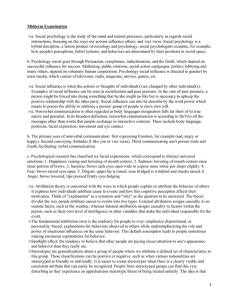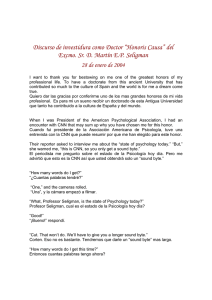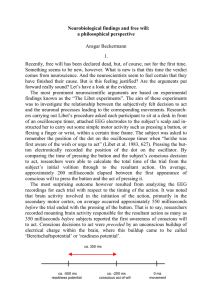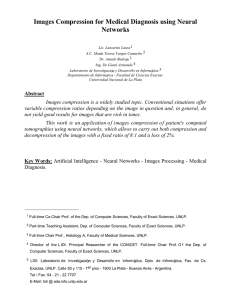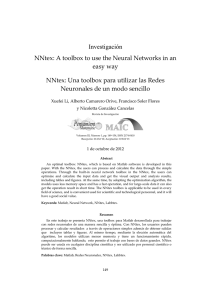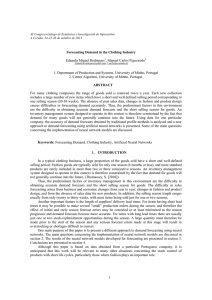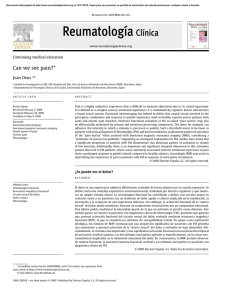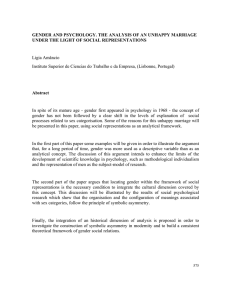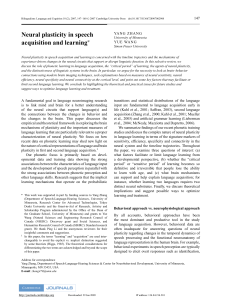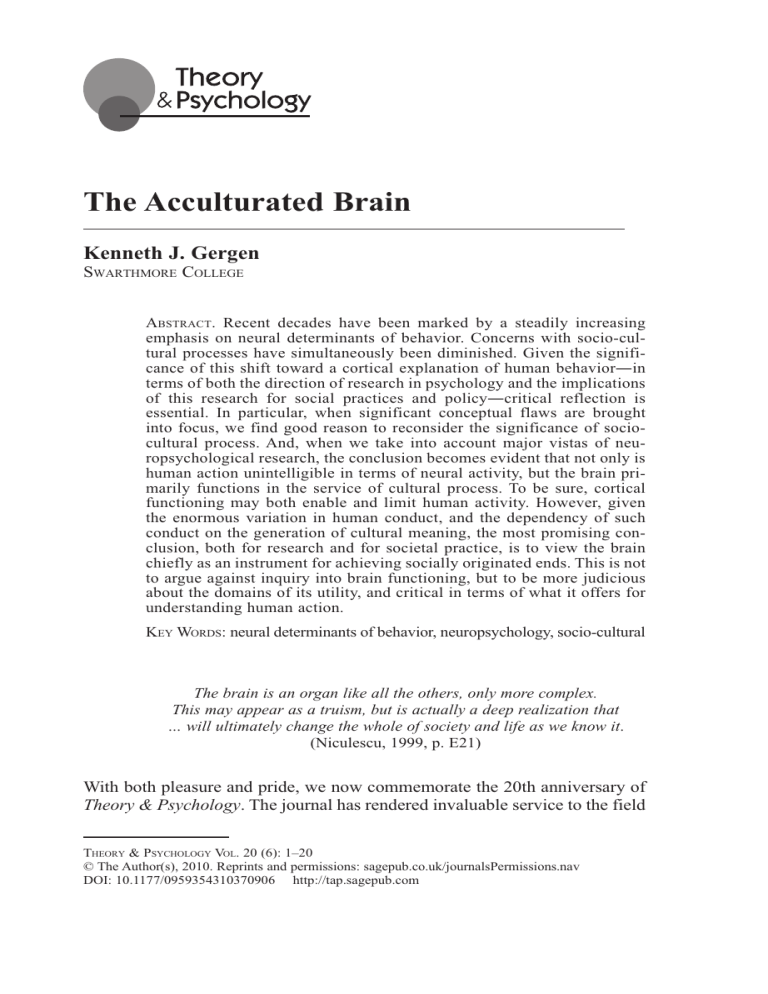
The Acculturated Brain Kenneth J. Gergen SWARTHMORE COLLEGE ABSTRACT. Recent decades have been marked by a steadily increasing emphasis on neural determinants of behavior. Concerns with socio-cultural processes have simultaneously been diminished. Given the significance of this shift toward a cortical explanation of human behavior―in terms of both the direction of research in psychology and the implications of this research for social practices and policy―critical reflection is essential. In particular, when significant conceptual flaws are brought into focus, we find good reason to reconsider the significance of sociocultural process. And, when we take into account major vistas of neuropsychological research, the conclusion becomes evident that not only is human action unintelligible in terms of neural activity, but the brain primarily functions in the service of cultural process. To be sure, cortical functioning may both enable and limit human activity. However, given the enormous variation in human conduct, and the dependency of such conduct on the generation of cultural meaning, the most promising conclusion, both for research and for societal practice, is to view the brain chiefly as an instrument for achieving socially originated ends. This is not to argue against inquiry into brain functioning, but to be more judicious about the domains of its utility, and critical in terms of what it offers for understanding human action. KEY WORDS: neural determinants of behavior, neuropsychology, socio-cultural The brain is an organ like all the others, only more complex. This may appear as a truism, but is actually a deep realization that … will ultimately change the whole of society and life as we know it. (Niculescu, 1999, p. E21) With both pleasure and pride, we now commemorate the 20th anniversary of Theory & Psychology. The journal has rendered invaluable service to the field THEORY & PSYCHOLOGY VOL. 20 (6): 1–20 © The Author(s), 2010. Reprints and permissions: sagepub.co.uk/journalsPermissions.nav DOI: 10.1177/0959354310370906 http://tap.sagepub.com 2 THEORY & PSYCHOLOGY 20(6) in its providing an unequaled forum for deliberation, catalytic critique, and innovation in psychological theory. Perhaps there is no better way to honor this anniversary than to confront what is undoubtedly the most important movement in psychology of the past decade. The emerging shift toward a brain-based understanding of human behavior is little short of remarkable. Both in terms of professional interest and public recognition, the “brain and behavior” movement is everywhere in evidence. Thus, we find accounts of the cortical basis of aggression (Siegel, 2004), happiness (Chemali, Chahine, & Naasan, 2008), altruism (Tankersley, Stowe, & Huettel, 2007), social understanding (Iacoboni, 2008), suicide (Schulte-Herbruggen & Roepke, 2008), emotion (Ledoux, 1998), economic and social decision making (Lee, 2008), romantic love (Bartels & Zeki, 2006; Fisher, Aron, & Brown, 2005), empathy (Lamm, Batson, & Decety, 2007; Singer et al., 2006), envy (Shamay-Tsoory, Tibi-Elhanany, & Aharon-Peretz, 2007), moral decision making (Casebeer, 2003), aesthetic judgment (Kirk, 2008), ethics (Marcus, 2002), jealousy (Rilling, Winslow, & Kilts, 2004), self-injury (Schroeder, Oster-Granite, & Thompson, 2002), personality structure (Depue & Collins, 1999), social values (Zahn et al., 2009), and cultural conflict (Wexler, 2006), among many others. Indeed, there is a largely shared presumption among many psychologists that virtually all psychological functioning can ultimately be traced to underlying origins in the brain. Historical Roots and Resistance For psychologists there has been long preparation for this shift toward cortical explanation. The 19th-century struggle to establish psychology as Naturwissenschaft as opposed to Geisteswissenschaft (essentially concerned with human meaning) was largely successful. Thus, by the early 1900s, William McDougall (1908) could propose that virtually all significant behavior is determined by biological instincts. In 1924 Floyd Allport began his famous treatise on social psychology with a chapter on the “physiological basis of human behavior.” In effect, a natural science of psychology required a grounding of mental process in neuro-physiology. The mid-century transformation from behaviorist to cognitive explanations of human behavior in psychology contributed further to the current condition. Once the presumption was in place that the major wellsprings of human activity were interior and inherent in nature, the obvious invitation was to explore the cortical basis of mental functioning. With their support of universal, inherent tendencies, developments in the allied fields of evolutionary psychology and behavioral genetics further increased the plausibility of cortical determination. And finally, with the emergence of multiple brain scanning devices (e.g., MRI, PET, EEG, MEG, TMS), the case was sealed. With such devices, it appeared that psychologists could at last move beyond inference and conjecture about GERGEN: THE ACCULTURATED BRAIN 3 mental states, to direct observation. This shift to neurological explanations simultaneously guaranteed psychology status as a natural science. In Edward O. Wilson’s (1998) terms, psychology could join the quest for consilience, or the grand unification of the sciences devoted to establishing natural laws. At the same time, for many psychologists this robust shift toward cortical explanation has generated misgivings. Of primary concern, support for inquiry into socio-cultural process was threatened. It is not simply that the high cost of brain and behavior research substantially reduced funds for research on social processes of education, prejudice, conflict reduction, social justice, cultural beliefs and values, organizational behavior, social change, cultural psychology, discourse processes, technology and behavior, social deviance, and the like. More importantly, as explanations for human behavior are reduced to the cortical level, attention to socio-cultural processes begins to expire. As sociologist Marshall Sahlins (1976) warned, biological theories of behavior should be judged not only on what they include in their formulations, but also in terms of what they leave out. As the anthropologist Emily Martin (2000) put it, social scientists should unite in “opposition to a position in which the dike between nature and culture has been breached, and all that [we] call culture has been drained through the hole and dissolved in the realm of neural networks” (p. 576). For many therapists, the shift toward neurological explanation also lends lends itself to the naturalization of the DSM categories, and to the rapid expansion of pharmaceutical “cures” for human problems. As it is reasoned, if human anguish largely results from the meanings attached to one’s activities, then therapy should properly be addressed to transformations in meaning as opposed to biology. As many see it, we are in danger of the body becoming a culture snatcher. It is commonly presumed that continuing research will ultimately determine the significance of cortical determinants of behavior. Yet, for scores of critics, such a view is dangerously shortsighted. As critics propose, in the very framing of their research scientists necessarily make ungrounded and culturally derived presumptions about human nature (Danziger, 1997; Gergen, Gülerce, Lock, & Misra, 1996). Thus, for example, to carry out research on the cortical location of emotion as opposed to reason is already to accept the Western distinction―largely emerging in the 18th century―between reason and emotion. Further, these a priori frameworks carry with them strong biases in the way one interprets research findings. For example, as I will later explore, one can interpret most of the data supporting a cortical explanation of human action as demonstrating the significance of cultural process. In this context, the questions that must be addressed have to do with the ideological and political impact of brain-based explanations. If such explanations are embraced by the society―treated as true beyond culture and history―what are the implications for social practices and policies? Given the vast popularization of brain-based explanations in the national media, these questions are of vital importance. 4 THEORY & PSYCHOLOGY 20(6) Such concerns have stimulated critique from many quarters. Socio-biology has long been under attack for its naturalization of gender differences, and particularly the way in which male infidelity is rationalized. Socio-biology has further suffered from critiques of its pivotal (and, for many, preposterous) presumption that social life is largely motivated and governed by the selfish pursuit to extend one’s genes (McKinnon, 2005). More directly relevant to brain research, however, is the charge of social and political conservativism invited by accounts of fixed behavioral tendencies. If behavior patterns are biologically necessitated, then we must more or less settle for the fact that rape, torture, murder, war, and genocide, for example, are “just human nature.” If we wish to see their reduction, we must build strong police forces, prisons, and armies. In this sense, the assumption of brain determination represents a form of neo-fatalism. In contrast, if we view such behaviors as cultural creations, transformation is within our grasp. In this case we are invited to consider ways in which together we might shift our priorities, values, and ways of life. In a world of hard-wired brains, “yes, we can” is of little moment. Critics are also concerned with the way in which the corticalization of human behavior robs human traditions of their significance. To propose that such activities as love, altruism, empathy, justice seeking, and worship are manifestations of neural determination is to transform their meaning. We begin to understand that phrases such as “I love you,” “I want to help you,” “I know what you are going through,” “I believe in social equality,” or “I thank my God” are reports on brain states. And with this transformation in meaning, esteemed cultural traditions are undermined. That an acquaintance reports his synapses to be in a state of agitation, for example, is not likely to invite romance, marriage, loyalty, nurturance, or bonding. To understand prayer or forgiveness as expressions of cortical architecture is to empty them of value. It is in this context that I wish to consider several pivotal assumptions under-girding research on the neurological determination of behavior. Beyond noting the shaky status of these assumptions, I will explore ways in which these assumptions are themselves byproducts of cultural process. As I will propose in this case: (a) all attempts to link brain states to psychological processes depend on culturally constructed conceptions of mind; (b) brain states can neither cause nor be correlated with psychological states or behavior; and (c) a dependency on “hard-wiring” explanations of behavior lends itself to unparsimoniousness and vacuity of theory. I will then turn to several lines of inquiry into neurological process. Here I will hope to demonstrate that: (a) neural research on plasticity argues against hard-wiring determination; (b) the capacity for context sensitive shifts in behavior militates against hard-wiring determination; and (c) everyday descriptions of human activity are ambiguously tied to specific patterns of behavior, rendering neural accounts of human activity largely irrelevant to everyday understanding. In effect, the brain in itself proves of limited significance in either determining or providing a basis for GERGEN: THE ACCULTURATED BRAIN 5 understanding human action. On the contrary, it is far more promising, both scientifically and in terms of societal value, to view the brain primarily as an instrument for achieving culturally constructed ends. This is not to deter a certain range of research into brain and behavior; it is, however, to suggest thoughtful restrictions over the kinds of research of promise to society. Concepts, Conundrums, and Culture It is first useful to consider premises substantiating the promise of brain research. How compelling are the conceptual foundations? Because of the sheer volume of such research, and the highly sophisticated technology on which it relies, one might conclude that it is deeply grounded. However, as we shall find, rather than offering clear and compelling promise of progress, such premises generate substantial problems. And, when more closely examined, we find the pervasive imprint of cultural influence. There are, of course, numerous methodological and substantive problems that have hovered over biologically based research on human behavior. Most research in evolutionary psychology is beset with the problematic assumption of post hoc ergo propter hoc. A common pattern of behavior is observed, and because an evolutionary advantage can be articulated, the pattern is then used to “verify” the explanation. As critics surmise, evolutionary psychology yields a body of just so stories, and in this sense functions as a pseudo-science (see Dupré, 2003; Rose & Rose, 2000). Both evolutionary and genetic orientations are further unsettled by research on epigenesist―or the influence of the environment on the expression of the genetic code. As myriad studies demonstrate, whether a given gene is activated depends importantly on environmental circumstances―intercellular, organic, and external to the body― and the time of life in which they occur (see. e.g., Booth & Neufer, 2005). Thus, for example, the activated genes for identical twins may vary substantially both over a lifetime and across social environments (Gibson, 2005). The indeterminacy of genetic make-up is intensified by the discover of so-called “rogue genes,” or genes that move across the genome in unpredictable ways (Lin & Avery, 1999). Any simple linking of the genome to brain functioning is thus precluded. In effect, evolutionary circumstances do not function identically across the population and genetic inheritance has no univocal effect on cortical functioning. Research on brain and behavior is further troubled by enormous methodological problems. As Dumit (2004) has summarized in the case of PET research, such studies suffer from problems in subject selection (e.g., “normal” vs. “schizophrenic”), sample size and representativeness, differential outcomes depending on subtle differences in the experimental tasks, defining a baseline or stage of rest, differing results depending on the time at which measures are taken after injection of the radioactive tracer, differing outcomes 6 THEORY & PSYCHOLOGY 20(6) depending on the composition of the tracer, and the ambiguity of defining regions of the brain. Further, as Raichle and Posner (1994) have demonstrated, different scanning devices yield different conclusions about the location and definition of brain activity. Indeed, Craig Bennett (in press) has shown, by adjusting one’s scanning techniques, it is even possible to demonstrate brain activity in a dead salmon. Yet, the frailties I wish to address here are more profound in implication. The concern is with the cultural saturation of the grounding assumptions and the implications for understanding the function of the brain in cultural life. Mind-Brain Relations as Cultural Artifacts I realized that I was often using my knowledge of myself to make sense of my genetic readout, not the other way around. (Pinker, 2009) A pivotal challenge for brain and behavior researchers is to locate specific regions, centers, or cortical mechanisms responsible for specific psychological functions. Without such linkages, indeed, there would be little in the way of neuropsychological explanation. Yet, this attempt has thus far proved elusive. In his critical analysis, William Uttal (2001) has examined at length the problems in developing, first, a taxonomy that can validly distinguish among mental states, and, second, a means of isolating specific regions of the brain. The problem of distinguishing among mental states can be traced primarily to the fact that there are no observable phenomena to facilitate ostensive definition (e.g., we cannot point to a mental phenomenon and say, “let’s call that ‘reasoning’”). Thus, there are numerous taxonomies of mental states and functions now extant, and no principled way of limiting any further conjectures. In the case of the brain, there are no definitive demarcations among brain regions. Thus, over time, there is significant fluctuation in the specific areas of the brain identified with various activities. As Uttal (1988) points out, different laboratories using different methods come to different conclusions, and replication across laboratories is rare. In the case of word meaning, for example, researchers have variously located the source in virtually all areas of the brain. But as one may ask, what is the “meaning of meaning”? This difficulty in distinguishing among mental conditions is particularly significant in light of one of the most important promises of neuroscience. Brain scan studies have been welcomed with enthusiasm by psychologists because they seem to provide an answer to the plaguing problem of psychological inference. This is the problem of inferring the existence of a psychological condition (e.g., depression) from overt behavior (e.g., inability to sleep). We posit an underlying world of mental states but we have no direct means of observing or accessing the states themselves. We cannot determine whether the lack of sleep is indeed an indicator of depression, anxiety, cognitive perseveration, anticipation, repression, or something else. Indeed, as earlier GERGEN: THE ACCULTURATED BRAIN 7 research has demonstrated (Gergen, Hepburn, & Comer, 1986), with sufficient ingenuity the observer can find reason to conclude that virtually any observable behavior is a manifestation of virtually any mental condition, or its reverse. All attempts to infer mental states from behavioral observation are suspended, then, on a network of conjectural assumptions. The chief question, however, is whether brain scan devices enable us to solve this otherwise intractable problem of inference. Let us take a closer look. Consider again the dilemma of psychological diagnosis: we are presented with a collection of expressions that we classify as symptoms of an underlying condition, but we have no access to the causal condition itself. In effect, we are forced to speculate that loss of appetite, lack of sleep, and feelings of hopelessness are symptoms of an underlying state of depression. We now observe the neural condition of the person we have shakily diagnosed as depressed. Indeed, we succeed in locating a pattern of neural activity unique to this population. Yet, we may ask, how can we determine that the observed state of the brain is in fact “depression”? Why is it not simply a neural correlate of sleeplessness, appetite loss, or feelings of helplessness? Or for that matter, how could we determine that the neural state is not one of “spiritual malaise,” “anger,” “withdrawal from oppressive conditions,” or “cognitive integration and regrouping”? In effect, brain scan data do not solve the problem of inference, but simply remove it from one site of speculation to another. Brain scans do not speak for themselves. To read them as evidence of depression, deceit, trust, empathy, political preferences, and so on, is essentially to participate in a tradition of cultural interpretation. In this sense, making connections between mind and brain is a form of cultural projection. That is, one must participate in a cultural tradition in which the existence of mental states is presumed in order to read brain scans in their terms. And there is no means by which a culture can ground the existence of the states that they take for granted. In studies of moral decision making, for example (e.g., Greene, Nystrom, Engell, Darley, & Cohen, 2004), researchers ask subjects to decide between smothering their baby or condemning yourself and others to death. In whose terms, however, is this a “moral decision”? And if confronted with such a dilemma, would it not also be possible that subjects would feel “anxious” about how they might be judged, “frustrated” by an insoluble problem, “imagining” the realities of such a situation, “recalling” relevant movies or books, feeling “fear” as their imagination takes shape, feeling “shame” that they should find themselves in such a situation, attempting to “suppress” their emotions at the decision they must make, and so on? The narrowness of the existing tradition from which neuroscience bases its interpretations is evidenced in the fact that there is virtually no research on the neurological basis of the melancholy, soul, psychological archetypes, spiritual malaise, or free will. Such concepts do not feature in the contemporary culture of science. It is also such biases that have led critics to view neuropsychology as a form of cultural imperialism. One 8 THEORY & PSYCHOLOGY 20(6) might ask, for example, why there has not been a lively interest in exploring the neural basis of karma, swabhava, swadharma, and stithi pragya, all significant to human functioning in Hindu psychology. It is not simply that there is little interest taken in the indigenous psychologies of other cultures, but such psychologies are largely viewed as “mere” folk theories. The Conundrum of Causality There is a longstanding distinction in Western culture between mind and body. This dualistic premise is as pervasive in brain and behavior research as it is problematic. The distinction is represented primarily in the assumption that the brain is a causal source of both mental states and behavior. We thus commonly speak of the neural basis, source, or grounds of cognition, emotion, altruism, aggression, and so on. Yet this assumption of the brain as a causal source raises major difficulties. There is, at the outset, Descartes’ intractable problem of how brain states affect mind states. If mind states are not material, then how are we to conceptualize the causal link between material and non-material worlds? Many neuroscientists escape this issue by avoiding causal assumptions and speaking in terms of “neural correlates” of various mental states. However, the problem with any such linkages takes an extra dimension in light of arguments in neuroscience for eliminating mental language. As reasoned by a number of scholars (see, e.g., Churchland & Churchland, 1998), the way in which we conceptualize “the mind” is essentially a social construction. Thus, it is contended, if there is to be a neuroscience of behavior, we must essentially eliminate the make-believe language of mind. As should be clear, this eliminative materialist view of neuroscience resonates with the argument in the preceding section for the “cultural reading” of the brain. Most importantly in this case, it effectively throws into question the causal or correlative relation between brain and mind. On this account, there is no obvious “world of mind” that stands as an effect for which the brain is a cause or a correlate. More formally, there is only neurophysiology. In this context, many researchers have found it more comfortable to return to the early behaviorist refrain: let us focus on visible behavior as opposed to inferred states of mind. We may thus focus on the relationship between cortical activity and a replicable world of observable behavior. This view also holds promise for therapeutic practitioners. If the source of the problem is fixed within the nervous system, then therapeutic intervention may reasonably focus on alteration of the nervous system. By analogy, if one’s automobile fails to function properly, engine repair may be required. It is this view that informed the early use of lobotomies and electro-shock to treat schizophrenia; at present, psychopharmacology has largely taken their place. GERGEN: THE ACCULTURATED BRAIN 9 At the same time, this argument is reasonable only to the extent that it is the structure of the machinery that is at fault. In some cases this is not an unreasonable assumption, and we shall return to it later in the paper. However, if the failure of the machinery can be traced to a prior cause―falling outside its confines―then correcting the machinery is only a temporary and possibly futile effort. If one’s engine does not function properly because one has failed to replenish its oil, then attention must be directed to the oil supply and not the properties of the engine. It is here that we are invited to look more closely at the methodology for determining the causal potency of the brain. The vast bulk of brain research relies on the experimental instigation of the brain state. Here, for example, researchers must establish a measurable neural condition, said to be responsible for problem solving, decision making, aggression, altruism, trust, and the like. In all such cases, however, various manipulations or instructions are required to bring the state of the brain into its condition. To instigate problem solving as a cortical condition, for example, requires that the subject is enlisted in the task of solving problems. It may thus be asked, on what grounds do we attribute the resulting behavior to the neural condition? It is not the brain that brings about problem solving, but the cultural conditions in which the very idea of solving problems and the kind of behavior defined as problem solving are nurtured. In this case the brain is simply a conduit that carries the cultural tradition. As social psychologists might say, we have here an application of the fundamental attribution error, the tendency to infer an internal cause of behavior without regard to the conditions bringing it about. In defense, one might draw from an alternative methodology, one that locates people with problematic behavior and then identifies a way in which the cortical functioning of this sub-population differs from the normal. In this context, for example, sub-populations of individuals diagnosed with schizophrenia, bi-polar disorder, ADHD, or obsessive compulsive personality disorder are compared with “normals.” Yet, while such research often reveals differences, the question of cause still remains. To what extent is it the brain condition that gives rise to the symptoms, as opposed to a history of preceding conditions that brings about the brain condition? If one lives for many years under oppressive, stressful, hopeless, or anxiety-provoking conditions, it is entirely possible that cortical connections are altered. In terms of cause and cure, we would thus be better served by focusing on cultural origins than on the mechanisms of their realization. And, if cultural conditions have brought about the condition of the brain, then altering the conditions of a client’s life would appear more beneficial than pharmacological sedation. Yet, in the final analysis, there is a philosophic problem that plagues the very idea of the brain as a cause of human behavior (M.R. Bennett & Hacker, 2003). In this case, the question is whether one may legitimately distinguish between the brain as a cause, for which bodily activity is an effect. How are 10 THEORY & PSYCHOLOGY 20(6) we to demarcate the brain from the remainder of the bodily activity of which it is a part? It is in this regard that more sophisticated neuroscientists propose that the brain is equal to behavior. At the same time, the brain is but a constituent part of the nervous system as a whole, and, separated from the remainder of the system, bodily movement is severely attenuated. In effect, it makes little sense to view the “brain as behavior” separated from the broader system of which it is a part. It is also apparent that the neural system is scarcely independent of the pulmonary system; each depends on the other for its functioning. And, too, neither of these could function effectively without the digestive system, skeletal structure, and so on. Remove any part of the system and “behavior” is essentially negated. Given that what we commonly distinguish as the brain acquires its function within the bodily system as a whole, it defies common meaning to assert that the movement of the body represents behavior, for which the brain is a cause. It is the functioning of the full array of interdependent bodily systems that is synonymous with behavior itself. Remove the functioning of this systemic process and there is no behavior; remove behavior and there is nothing remaining to be called the body. The traditional distinction between brain and behavior is erased, and likewise the view that the brain is a cause or basis of behavior. The implications here are not trivial. Claims to the effect that there is a neural basis for learning, memory, empathy, aggression, and so on, are essentially empty. What the physiologist describes in neural terms, the common person on the street will call learning, memory, empathy, and so on. There are not two worlds, the one responsible for the other. To claim that there is a neural source for behavior is similar to saying that the source of a forest can be traced to its trees. From Unparsimoniousness to Vacuity In William McDougall’s classic work (1908), the attempt was to trace most prevalent forms of social behavior to genetically based instincts. Thus, for example, McDougall proposed inherent dispositions toward reproduction, parenting, pugnacity, gregariousness, acquisition of goods, developing habits, and more. However, this view came under attack by scores of psychologists and was soon abandoned. The chief critique was that instinct theory led to few useful or interesting predictions. One simply concluded that, in effect, people just do what they do because it is instinctive to do so. Second, however, instinct theory was unparsimonious. With each new behavior, the researcher was invited to posit a new instinct. We confront this same condition in the case of neurological explanations of human behavior. It is not simply that such commonly recognized behaviors as aggression, altruism, decision making, mathematical reasoning, language, and the like, are traced to brain structure, but researchers now extend the perimeters of reductionism by identifying the cortical centers responsible for such wide-ranging activities GERGEN: THE ACCULTURATED BRAIN 11 as moral decision making, prayer, meditation, consumer choice, and political party preference. Further, when groups differ in behavioral tendencies (e.g., mental illness, criminality, leadership), the stage is set for positing additional neruo-genetic differences. The future research trajectory is clear enough: so long as the researcher can identity a distinct form of human activity, he or she may also set out to reveal its neural “underpinnings.” Within this paradigm, the catalogue of neurally determined behavior will undergo infinite expansion, while simultaneously narrowing the options for prediction and understanding. Yet, as a phalanx of culturally sensitive critics point out, there are vast differences among people in their behavior. In the case of aggression, for example, Westerners find monstrous the practices of beheading, suicide bombing, and death by stoning prevalent in other cultures; for non-Westerners, our use of electric chairs, napalm, and atomic bombs stands in similar regard. Given the prevalence of such variations, it is asked, how can one make strong claims for cortical determination? The major rejoinder to such critiques is that cultural process can bend or shape the “instinctual” tendencies in varying directions. The underlying tendencies nevertheless remain firm. To illustrate, broad claims are made to the genetic determination of what are called “the basic emotions.” What we in the West term anger, sadness, disgust, and fear are said to be universal in scope. To be sure, it is proposed, there are cultural variations in how and when such emotions are expressed, but the concept of socially acquired “display rules” accounts for these variations (Matsumoto, Yoo, & Fontaine, 2008). Ultimately the logic of display rules threatens the neuro-project with vacuity. It ensures that presumptions of neurological determination cannot be threatened by countervailing evidence. All culturally specific variations may be attributed to a cultural patina that occludes our vision of the universal tendencies. Worse still, this logic ensures that the ideological and political applications of the orientation remain beyond question. And yet, we may ask, when in cultural history did we begin to presume that widely shared patterns of behavior are a manifestation of cortical structure? Why should we grant priority to biological explanation? If aggression is universal, for example, we may very well suppose that people everywhere have found it an easy solution to various problems, in much the same way they have found it useful to make fires, grow crops, or cook their food. In seeing these activities as cultural in origin, not only do we open broad vistas of explanation, but we can envision the possibility of alternative futures. The Brain as Culture Carrier As we find, assumptions central to neurologically based explanations of mind and behavior are both insubstantial and freighted with cultural biases of the very kind that such research is at pains to suppress. The reading of brain states 12 THEORY & PSYCHOLOGY 20(6) approximates a projection of cultural tradition, and the Western tradition of mind/body dualism creates intractable problems of explanation. We turn now to neurological research findings. Here we shall find that when closely examined, most brain research is irrelevant to understanding human action. Indeed, the brain functions primarily as a vehicle for achieving culturally constructed ends. Plasticity and Protean Potential The longstanding view among brain and behavior researchers is that we are largely “hard wired” to think and act as we do. Yet, if this were so, it is difficult to comprehend the fluidity with which we commonly move across our daily activities. If we were indeed saddled with genetic dispositions, the result would be a radical loss in flexibility. In a humorous vein, consider Woody Allen’s (2008) first-person account of what it might be like to possess an inherent tendency to remember. You are on your way to a party, but there is a question about the gift you are to bring to the host: Of course, I left Mr. Wasserfiend’s gift at the office. My secretary, Miss Facework, to meet me with it at the party. Car keys in gray cashmere cardigan on second hanger in hall closet. Remember the day I bought that cardigan, sixteen years ago. A Tuesday. I was wearing beige slacks and a Sulka button-down oxford shift. Gray socks. Shoes from Flagg Brothers. Had lunch with Sol Kashflow, a hedge-fund whiz. Sol ordered the halibut with buttered peas and julienne potatoes. His beverage white wine, a ’64 Batard-Montrachet, which I recall was a tad fruity. Finished off with a lime sorbet and two after dinner mints- or was it three? ... I got the check. Fiftysix dollars and ninety-eight cents. Hardly worth it, since my langoustines were overcooked. To the Wasserfiends’ party at last. (p. 42) In effect, a tendency toward continuous memory would be dysfunctional; adaptation to normal life requires the capacity to move from one form of activity to another. One is not, for example, aggressive, altruistic, empathic, or envious without end. Sensitivity to the specific and often subtle requirements of the situation is imperative. And, by and large, these requirements are cultural in origin. The problem of cortical determination is only intensified by the fact that neuro-researchers make claims to hard-wired dispositions that are opposed in their outcomes. As variously “demonstrated,” we are genetically disposed to both selfishness and altruism, successful and unsuccessful problem solving, empathy and punishment of norm violators, morality and immorality, and so on. In this context, it seems far more reasonable to view the brain not as prophetic, but as preparatory in function. That is, it is an organ specifically preparing the individual for protean action, for continuously responding, innovating, and initiating, as the conditions of life unfold over time. It is at just this point that an enormous body of evidence for neural plasticity becomes relevant. As wide-ranging research has demonstrated, the brain is engaged in a continuous process of reorganization through the formation of new neural GERGEN: THE ACCULTURATED BRAIN 13 connections (see, e.g., Berlin & Weyland, 2003; Doidge, 2007; Pinaud, Tremere, & DeWeerd, 2006). There are two important conclusions suggested by such research. First, the process of neurogenesis (or the generation of new neurons) is continuous. Although accelerated in the pre-natal period, neurogenesis continues into old age. Especially with sufficient exercise, environmental stimulation, and caloric restriction, new neurons may be generated within the mature brain. In effect, the process lends itself to a picture of the brain as both responsive to alterations in the environment, and in a state of self-preparation for novel demands. Second, research on brain plasticity reveals that neural pathways may be transformed over time in such a way that a deficit in brain function in one region may be compensated by the development of new neural pathways. It is this process of plasticity that enables those with injuries to the nervous system to engage in exercise that may restore potentials for effective action. Not only do such findings undermine the concept of behavior determined by a fixed architecture of the brain, they suggest once again that the brain absorbs or reflects its cultural surrounds and enables the individual to act more effectively within them. The Weight of Wiring and the Crucible of “Could I Do Otherwise?” The view of the brain as preparing the human being for protean activity also raises important questions concerning the power of inherent biological tendencies. If we are indeed granted a certain degree of biological determination of behavior, what is the comparative strength of such determinants in comparison to cultural influences? For example, it is a well-accepted fact that humans are positively disposed toward the taste of sweetness. However, dieters generally find that sacrificing sweets is one of the easier challenges they confront. Conversely, there are numerous forms of addiction, such as cigarettes and alcohol, for which there is no obvious hard-wired determination, and against which supposed “selfish” or self-sustaining genes seem impotent. This question of comparative weight is raised most obviously in evolutionary psychology research. Here we find elaborate arguments made for selfish gene theory, but the confirming evidence is typically based on minor population differences. And of course, with a sufficiently large sample size, even the smallest population differences yield statistical significance. In effect, the power of evolutionary determination, if it exists at all, seems scant. I am scarcely proposing that all psychological research is essentially a reflection of cultural conventions. There may truly be cases in which a biological orientation is appropriate and effective. Damage to various areas of the brain, for example, may necessarily entail or limit various forms of activity. Let me propose, however, a first-approximation method for assessing the relevance of fixed biological tendencies as opposed to culturally generated forms of behavior. Here medical science provides a useful model. The causes of diseases such as malaria and smallpox are relatively predictable, as are the 14 THEORY & PSYCHOLOGY 20(6) courses of the illness and the effects of available cures or preventatives. Further, we may be relatively certain of universal generalization. Regardless of culture, the causes and cures are likely to be similar. Finally, and most important in this case, if challenged to reverse the course of determination, one could not do so. One afflicted by the disease could not one day simply turn and walk free. Biology clearly holds sway over culture. Let us then establish the question, “Could I do otherwise?” as a rough crucible against which we may assess the power of biological determination. If presented with a behavior pattern for which claims are made to inherent necessity, could I chose not to behave in this way or to act in some other way? Now, let us apply this crucible to the vast array of research in which psychologists are engaged. One is first suspicious of the socio-cultural fragility of such findings by the fact that pains are typically taken to ensure that experimental participants are ignorant of the research hypotheses. As commonly reasoned, with awareness of the hypotheses, participants might bias the results by acting to confirm or disconfirm them. With strong biological determination, consciousness of the hypotheses should make little difference. One cannot choose to terminate the beating of the heart, the processing of oxygen by the lungs, or the digestive process of the intestinal tract, save by terminating one’s existence as a living being. However, if challenged to do otherwise, children would not model adult behavior, adults would resist responding to helplessness with depression, participants would not respond to hostility with aggression, and so on. To press the issue further, the most broadly visible research in psychology owes its place in the sun to the very fact that it demonstrates patterns of behavior in which we ought not to engage. The importance of the finding lies in its implicit moral message: now that you are aware, do otherwise. This logic is most obvious in traditional studies of conformity (Asch, 1955), obedience (Milgram, 1974), and groupthink (Janis, 1972). Such studies essentially function as moral injunctions. Although more subtle, moral warnings are implicit in studies of cognitive dissonance and inter-group relations, the former pointing to the silly things people do to avoid inconsistency and the latter to the evils of in-group preference. This emancipatory quality is evident as well in Kahneman and Tversky’s (1973) famous studies on cognitive heuristics. It might be difficult for most people to apply Bayesian theory to probability estimates, as such research suggests. However, those trained in Bayesian heuristics can easily do so. Such research findings are essentially reflections of cultural training. When we turn to research in which claims are made to cortical determination, we find that the vast preponderance is focused on behavior patterns that are highly pliable. There may be demonstrable cortical correlates of aggression, altruism, ideological rigidity, moral behavior, anger, and the like, but there is typically a wide latitude of choice as to whether one chooses to engage in any of these activities. For example, as de Quervain and her GERGEN: THE ACCULTURATED BRAIN 15 colleagues (2004) attempt to demonstrate, humans are hard wired to punish those who violate norms. Yet, if challenged to respond to norm violators with understanding as opposed to punishment, it is difficult to imagine people being unable to do so. Indeed, that this latitude of choice is suppressed by such research invites the critical charge that brain research is socially conservative. One is discouraged from considering the alternatives. Human Behavior as Cultural Action: Blinks and Winks There is a final issue at stake, one which simultaneously delimits the significance of brain research in understanding human behavior, and asserts most profoundly the importance of culturally sensitive inquiry. The analogy of the clock is a useful entry to the problem. The physical mechanism of a clock may be fully understood; the functioning of its parts wholly predictable; and its operation wholly subject to what scientists might see as universal laws of cause and effect. Yet, there is nothing about the physical functioning of the clock that yields information about time. That a clock furnishes us the time of day is entirely dependent upon shared agreements within the culture. An engineer may know everything about the physical mechanism of the clock, but with this knowledge alone, he or she could not derive the concept of 4 p.m. In effect, the culture uses the movement of the clock for purposes of its own creation; there is nothing about the clock that determines or demands the concept of time. In the same way, the physical workings of an automobile tell us nothing about its “heading north,” or the neurology of the body that I am “on my way to work.” More generally, it may be surmised that we have here two discourses, each generated within a social group to achieve its own purposes. The discursive community of the clock maker employs its discourse to manufacture a precisely functioning mechanism. The culture more generally uses the same functioning to assist its synchronizing activities. By virtue of social agreements about the meaning of time, the clock can be used to establish meetings, order events, organize group actions, and so on. There is little cultural concern with the physical workings of the apparatus because the physical principles governing the working of the apparatus are largely irrelevant to daily life. Regarding the clock maker, other than for purposes of sales, he or she doesn’t care in what manner the culture constructs the time. To return to the earlier issue of causality, it makes little sense to say that the working of the clock as a physical instrument is the causal basis (a “hard-wired origin”) of the time. We are dealing here not with cause and effect, but with two functionally distinct discourses. Similarly, from this perspective, the pesky problem of reductionism vanishes. One cannot reduce the discourse of time to the functioning of the machine parts. The functioning of the clock will allow the culture to establish “closing time,” “time of departure,” and “when the stock market opens in Tokyo,” but such concepts are irrelevant to the way in which clock makers discuss how to make a more efficient device. 16 THEORY & PSYCHOLOGY 20(6) Given the possibility of multiple discourses, we further see that the same physical movement may have different meanings for different people. Consider the brief closing and opening of the eyelid. From a biological standpoint, one might roughly call such a movement a “blink.” However, from a cultural standpoint, the same activity may be viewed as a “wink.” To understand the winking of the eye, the biologist might explore the functioning of tear ducts, the drying of the retina, and so on. As a wink, however, the action may bring forth a variety of different activities. For some the action may “call hither”; for others it may yield a knowing smile; and for still others, it may be repelling. The same form of biological activity may serve many different cultural functions. By the same token, many different movements of the body may have the same cultural significance. Thus, for example, a psychiatrist may attribute attention deficit disorder to a child who fidgets in his chair, walks around the classroom oblivious to the teacher, talks incessantly, or continuously shifts his gaze about the room. There is no singular form of movement that counts as attention deficit; rather, the deficit is derived from the function assigned to the behavior by the culture. More generally it may be said that in carrying out cultural life, it is useful to describe various people as “aggressive,” “moral,” “helpful,” “dishonest,” “humorous,” and the like. We may usefully describe our emotional expressions as “anger,” “happiness,” or “love.” Yet, while such discourse is critical to living an effective life within the culture, none of these descriptors is linked to determinate movements of the body. Under certain circumstances virtually any movement of the body may count as anger, happiness, or an expression of love. Yet, it is precisely the movements of the body of which brain functioning is part. In this sense, neurology may be centrally involved with bodily movement, but it has little to do with cultural meaning of the movement. The brain may enable people to play the game of tennis, for example, but it requires neither the game nor the movements that constitute proper play. And, judging by the seeming fact that people’s lives are built around the culturally created meaning of family, friends, a promising job, the love and respect of others, social justice, religion, and the like, we may conclude that while the brain may be a major facilitator of our actions, it is not their progenitor. The Place of Brain Science As we find, research on brain plasticity, along with the human potential for mercurial shifts in behavior, strongly suggests that the brain facilitates rather than determines most human conduct. Such a conclusion is also reinforced by a consideration of the pivotal place of culturally created meaning both in directing action and in determining its significance. This is not at all to argue GERGEN: THE ACCULTURATED BRAIN 17 for a termination of research into brain and behavior. Many brain researchers do not ascribe to all the assumptions and practices toward which the present critique is focused. Many are highly circumspect with respect to the claims they make, and more judicious in their choices of research topics. Most importantly, there are robust forms of brain research that may prove of inestimable value to the society, and it is important to develop sound criteria for distinguishing between research of such promise as opposed to that which is misleading and/or culturally debilitating. For example, as developments in technology are improved, it is likely that virtually all human behavior may be represented by significant patterns of brain activity. This would surely include differential patterns of brain activity for actors playing Hamlet, Othello, and King Lear. However, to conclude that Hamlet, Othello, and Lear are the products of cortical architecture and function, as current research fashions suggest, is obvious folly. It is essential, then, that we direct serious attention to the issue of significant criteria of research. As a stimulus to this discussion, I offer in closing three relevant considerations. Application of the “Could I Do Otherwise?” Criterion As a preliminary question, one may ask of studies of brain and behavior whether the behavior in question is characterized by a high degree of individual and/or cross-cultural malleability. That is to say, if a substantial proportion of the population could, upon request, choose not to engage in a common form of behavior, then we might reasonably suspect that the contribution of cortical architecture to the common pattern is minimal. In effect, brain functioning may enable people to engage in the activity, but does not effectively require it. While the application of such a criterion would substantially reduce the range of study, there are domains of ambiguity. For example, what may be said of those who experience great difficulty in executing a given behavior, such as reading, writing, or focusing attention? They cannot easily choose to do otherwise. Here it is important to distinguish between the radical proposal that the brain is responsible for a given activity, and the more tempered view of the brain as a limiting or facilitating organ. There are dramatically different social implications between the conclusion that “my brain made me do it, and “my brain prevents my doing it.” In the latter case, there is considerable utility in determining whether a given incapacity, for example, is cortically determined. It would be useful to know if symptoms characterized as autism resulted from neurological as opposed to social factors―or some combination. At the same time, it should be realized that advances in restoration practices cannot proceed without the contribution of culturally sensitive research. That neurogenesis may contribute to restoration does not inform us of the contributing behavioral practices, or the cultural meanings that must be set in place to secure the patient’s commitment to such practices. 18 THEORY & PSYCHOLOGY 20(6) Consideration of Cultural Interpretations and Values Brain and behavior research is both influenced by the surrounding culture, and, in turn, acts upon forms of cultural life. In evaluating the significance of brain research, it is thus important to inquire into its moral and political ramifications. In cases of what is commonly viewed as brain damage, for example, researchers are quite likely to share the values and conceptions of the culture at large. There is widely shared agreement in the value of restoring the individual to what most conceive of as normal functioning. A cortical explanation and neuro-centered treatment may be favored. However, at the other end of the spectrum, there are enormous differences in how people view happiness, morality, and love, and the values they attach to these constructions. It is bad-faith science to disregard these differences. Because professional interpretations of human action enter the society as “truth bearing,” there is no morally or politically neutral research. Again, the grey areas demand attention. A major exemplar is represented in research into the neural basis of mental illness (see, e.g., Gottesman & Gould, 2003; Nestler & Charney, 2004). As suggested by cross-cultural, historical, and demographic research, there are broad and significant differences in what is counted as deviant in cultural life, how it is understood, and the cultural practices in which it is embedded (see, e.g., Hacking, 1995; Hepworth, 1999; Lerman, 1996). For psychiatrists in contemporary America, deviance is typically defined in terms of “mental illness,” and steadily increasing attempts are made to link DSM categories to neurological deficit and to provide chemically based treatment. Yet to capitulate to this movement is to suppress or obliterate the rich variations in cultural meaning and value that may otherwise (and often successfully) be attached to what is being defined as mental illness. For example, there is nothing inherently “ill” about what might be commonly viewed as a highly active child. Nor is the child him- or herself in a state of anguish. The label of “attention deficit disorder” primarily results from the teacher’s inability to sustain an orderly and effective classroom, combined with the psychiatrist’s willingness to define the behavior as mental illness, and the profits garnered by the pharmaceutical industry. Virtually no attention is thus directed to teaching practices more optimally suited for varied student proclivities, or the cultural conditions that favor hyper-activity (e.g., electronic games). To embark on research into the neurological basis of attention deficit disorder without broad-ranging dialogue concerning interpretation and values is culturally irresponsible. Focus on Brain as Behavior This final criterion may be the most important, as it incorporates elements of both the preceding. As previously discussed, one of the major problems besetting brain research stems from the traditional bifurcation between brain and behavior. Rather, as proposed, it is more appropriate to view the brain as but one participant in a bodily system in motion. Thus, there is no essential GERGEN: THE ACCULTURATED BRAIN 19 distinction between brain and behavior; instead, there is simply bodily behavior within which brain functioning may play an important role. In terms of future research, a focus on the bodily system has important implications. First, we may separate out research on bodily behavior from interpretations of human action that serve social purposes. In previous terms, there is good reason for neural research on the blinking of the eye, but not on winking. From this standpoint, there is reason to question research on the cortical contribution to leadership, morality, suicide, love, jealousy, altruism, and the like. Such descriptors of human action serve important social functions, but are tied only loosely (if at all) to specific movements of the body. However, the study of the neural mechanisms involved in aphasia, Down’s syndrome, Parkinson’s disease, or brain tumors may serve vitally useful purposes. In Conclusion The way in which we understand human functioning, along with the importance we attribute to the brain, is fundamentally a byproduct of cultural process. Cultural process in this case includes the creation of meaning within wide-ranging enclaves (e.g., neuroscience, sociology, humanistic psychology, evolutionary psychology, the media, religious groups). In this sense there is no Truth about the brain and its relationship to human activity. There are multiple perspectives, each with its own particular assumptions, values, and goals. As one might say, the brain does not determine the contours of cultural life; cultural life determines what we take to be the nature and importance of brain functioning. Putting aside the question of Truth, we may then ask about the pragmatic implications of various constructions of the relation between brain functioning and human action. As I have proposed, much of the existing research in neuro-psychology contributes little of practical value to cultural life. And in significant ways, one may locate misleading or detrimental consequences. At the same time, if we take the view of the brain as an organ that enables the realization of culturally created forms of life, we open the door to a far richer and more promising domain of research and practice. Given the rapidly expanding romance with cortical explanations of human action, it is imperative that close attention be directed to criteria for identifying research of practical value to the culture more generally. Issues of cultural variation, the plurality of values, and the functional separation of discourses should all play a role in such evaluations. References Allen, W. (2008, November 10). Think hard, it’ll come back to you. The New Yorker, p. 42. Allport, F.H. (1924). Social psychology. New York, NY: Macmillan. Asch, S. (1955). Opinions and social pressure. Scientific American, 193, 31-35. 20 THEORY & PSYCHOLOGY 20(6) Bartels, A., & Zeki, S. (2006). The neural basis of romantic love. London, UK: University College London. Bennett, C. (in press). Neural correlates of inter-species perspective taking in the postmortem Atlantic salmon: An argument for proper multiple comparisons correction. Human Brain Mapping. Bennett, M.R., & Hacker, P.M.S. (2003). Philosophical foundations of neuroscience. Oxford, UK: Blackwell. Berlin, C.I., & Weyland, T. (2003). The brain and sensory plasticity: Language acquisition and hearing. Boston, MA: Delmar. Booth, F.W., & Neufer, P.D. (2005). Exercise controls gene expression. American Scientist, 93, 8-35. Casebeer, W.D. (2003). Natural ethical facts: Evolution, connectionism, and moral cognition. Cambridge, MA: MIT Press. Chemali, Z., Chahine, L., & Naassan, G. (2008). On happiness: A minimalist perspective on a complex neural circuitry and its psychosocial constructs. Journal of Happiness Studies, 9, 489-501. Churchland, P.M., & Churchland, P.S. (1998). On the contrary: Critical essays 19871997. Cambridge, MA: MIT Press. Danziger, K. (1997) Naming the mind. How psychology found its language. London, UK: Sage. Depue, R.A., & Collins, P.F. (1999). Neurobiology of the structure of personality: Dopamine, facilitation of incentive motivation, and extroversion. Behavioral and Brain Sciences, 22, 491-517. de Quervain, D., Fischbach, U., Treyer, V., Schellhammer, M., Schnyder, U., Buck, A., & Fehr, E. (2004). The neural basis of altruistic punishment. Science, 305, 12541258. Doidge, N. (2007). The brain that changes itself: Stories of personal triumph from the frontiers of brain science. New York, NY: Penguin Dumit, J. (2004). Picturing personhood, brain scans and biomedical identity. Princeton, NJ: Princeton University Press. Dupré, J. (2003). Human nature and the limits of science. Oxford, UK: Oxford University Press. Fisher, H., Aron, A., & Brown, L. (2005). Romantic love: An fMRI study of a neural mechanism for mate choice. The Journal of Comparative Neurology, 493(1), 58-62. Gergen, K.J., Gülerce, A., Lock, A., & Misra, G. (1996). Psychological science in cultural context. American Psychologist, 51, 496-503. Gergen, K.J., Hepburn, A., & Comer, D. (1986). The hermeneutics of personality description. Journal of Personality and Social Psychology, 6, 1261-1270. Gibson, K.R. (2005). Epigenesis, brain plasticity, and behavioral versatility: Alternatives to standard evolutionary psychological models. In S. McKinnon & S. Silverman (Eds.), Complexities: Beyond nature and nurture (pp. 112-124). Chicago, IL: University of Chicago Press. Gottesman, I., & Gould, T.D. (2003). The endophenotype concept in psychiatry: Etymology and strategic intentions. American Journal of Psychiatry, 160, 636-645. Greene, J.D., Nystrom, L.E., Engell, A.D., Darley, J.M., & Cohen, J.D. (2004). The neural bases of cognitive conflict and control in moral judgment. Neuron, 44, 389-400. Hacking, I. (1995). Rewriting the soul: Multiple personality and the science of memory. Princeton, NJ: Princeton University Press. GERGEN: THE ACCULTURATED BRAIN 21 Hepworth, J. (1999). The social construction of anorexia nervosa. London, UK: Sage. Iacoboni, M. (2008). Mirroring people: The new science of how we connect with others. New York, NY: Farrar Straus & Giroux. Janis, I. (1972). Victims of groupthink. Boston, MA: Houghton Mifflin. Kahenaman, D., & Tversky, A. (1973). On the psychology of prediction. Psychological Review, 80, 237-251. Kirk, U. (2008). The neural basis of object-context relationships on aesthetic judgment. PLoS ONE, 3(11), e3754. doi: 10.1371/journal.pone.0003754 Lamm, C., Batson, C.D., & Decety, J. (2007). The neural substrate of human empathy: Effects of perspective-taking and cognitive appraisal. Journal of Cognitive Neuroscience, 19, 42-58. Ledoux, J. (1998). The emotional brain: The mysterious underpinnings of emotional life. New York, NY: Simon & Schuster. Lee, D. (2008). Game theory and neural basis of social decision making. Nature Neuroscience, 11, 404-409. Lerman, H. (1996). Pigeonholing women’s misery: A history and critical analysis of the psychodiagnosis of women in the twentieth century. New York: Basic Books. Lin, R., & Avery, L. (1999). RNA interference: Policing rogue genes. Nature, 402, 128-129. doi: 10.1038/45938 Marcus, S.J. (Ed.). (2002). Neuroethics: Mapping the field. San Francisco, CA: Dana Press. Martin, E. (2000). Mind-body problems. American Ethnologist, 27, 569-590. Matsumoto, D., Yoo, S.H., & Fontaine, J. (2008). Mapping expressive differences around the world: The relationship between emotional display rules and individualism and collectivism. Journal of Cross-Cultural Psychology, 39, 55-74. McDougall, W. (1908). An introduction to social psychology. London, UK: Methuen. McKinnon, S. (2005). Neo-liberal genetics: The myths and moral tales of evolutionary psychology. Chicago, IL: Prickly Paradigm Press. Milgram, S. (1974). Obedience to authority: An experimental view. New York, NY: Harper & Row. Nestler, E.J., & Charney, D.S. (Eds.). (2004). Neurobiology of mental illness. New York, NY: Oxford University Press. Niculescu, A.B. (1999). Brainology. Medscape General Medicine, 1, E21. Pinaud, R., Tremere, L., & DeWeerd, P. (Eds.). (2006). Plasticity in the visual system, from genes to circuits. New York, NY: Springer. Pinker, S. (2009, January 7) My genome, my self. New York Times Magazine. Retrieved from http://www.nytimes.com/2009/01/11/magazine/11Genome-t.html?pagewanted =1&_r=1&sq=My%20genome&st=nyt&scp=1 Raichle, M.E., & Posner, M. I. (1994). Images of mind. New York, NY: W.H. Freeman. Rilling, J.K., Winslow, J.T., & Kilts, C.D. (2004). The neural correlates of mate competition in dominant male rhesus macaques. Biological Psychiatry, 56, 364-375. Rose, H., & Rose, S. (Eds.). (2000) Alas, poor Darwin: Arguments against evolutionary psychology. New York, NY: Harmony Books. Sahlins, M.D. (1976). The use and abuse of biology. Ann Arbor: University of Michigan Press. Schroeder, S.R., Oster-Granite, M.L., & Thompson, T. (Eds.). (2002). Self-injurious behavior: Gene-brain behavior relationships. Washington, DC: American Psychological Association. 22 THEORY & PSYCHOLOGY 20(6) Schulte-Herbruggen, O., & Roepke, S. (2008). Functional neural basis of suicidal behavior in depression. American Journal of Psychiatry, 165, 1203. Shamay-Tsoory, S.G., Tibi-Elhanany, Y., & Aharon-Peretz, J. (2007). The green-eyed monster and malicious joy: The neuroanatomical bases of envy and gloating (Schadenfreude). Brain, 130, 1663-1678. doi: 10.1093/brain/awm093 Siegel, A. (2004). Neurobiology of aggression and rage. New York, NY: Informa Health Care. Singer, T., Seymour, B., O’Doherty, J.P., Stephan, K.E., Dolan, R.J., & Frith, C.D. (2006, January 26). Empathic neural responses are modulated by the perceived fairness of others. Nature, 439, 466-469. doi: 10.1038/nature04271 Tankersley, D., Stowe, C.J., & Huettel, S.A. (2007, February). Altruism is associated with an increased neural response to agency. Nature Neuroscience, 10, 150-151. Uttal, W.R. (1988). On seeing forms. Hillsdale, NJ: Erlbaum. Uttal, W.R. (2001). The new phrenology. Cambridge, MA: MIT Press. Wexler, B.E. (2006) Brain and culture: Neurbiology, ideology, and social change. Cambridge, MA: MIT Press. Wilson, E.O. (1998). Consilience: The unity of knowledge. New York, NY: Knopf. Zahn, R., Moll, J., Paiva, M., Garrido, G., Krueger, F., Huey, E.D., & Grafman, J. (2009). The neural basis of human social values: Evidence from Functional MRI. Cerebral Cortex, 19, 276-283. KENNETH J. GERGEN is a Senior Research Professor at Swarthmore College, and the president of the Taos Institute. His chief interest is in in the coordinated constructions of reality, rationality, and morality and their implications for cultural life. His most recent book is Relational Being: Beyond Self and Community (Oxford University Press, 2009). ADDRESS: Department of Psychology, Swarthmore College, Swarthmore, PA 19086, USA. [email: kgergen1@swarthmore.edu]


